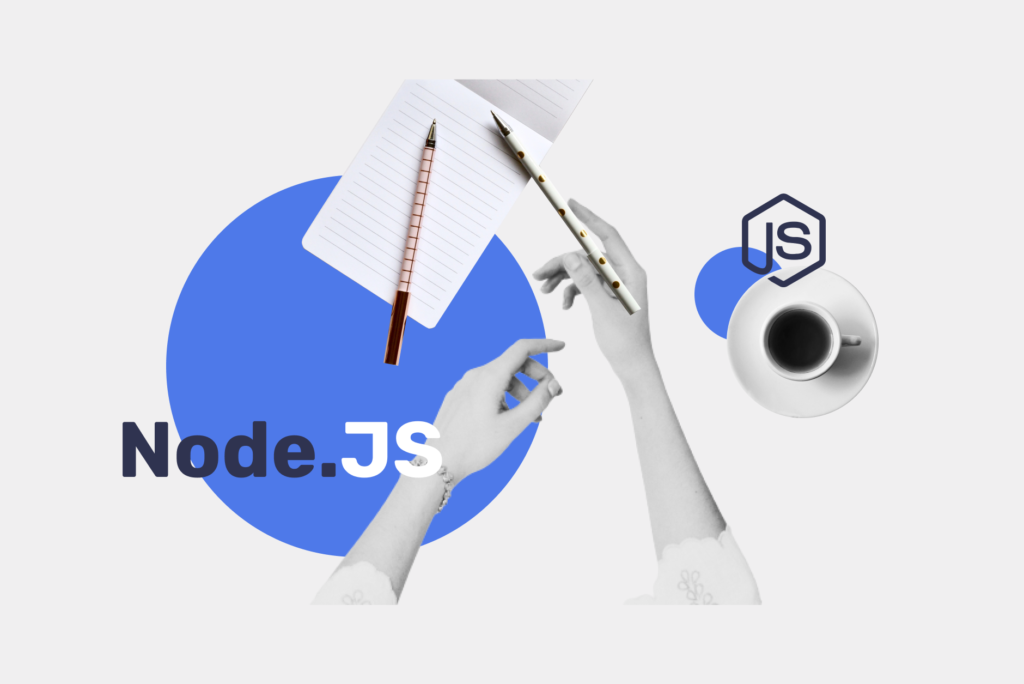Node.js has quickly won developers’ hearts around the globe, and there are many good reasons why. First off, it expands the opportunity of JavaScript and thus provides better processing capability. Plus, it is one of the leading technologies to cover an entire stack of development.
According to statistics, Node.js increases performance by 50% and reduces development costs by 58%. More than 28,000 websites in the US are using this framework. Among them are such well-known services as Paypal, Netflix, LinkedIn, Reddit, Medium, eBay, and more.
There is no doubt Node.js is a good choice. You need a strong team to build your solution using this technology. If you are a non-technical product owner, or you have little understanding of this framework, you may face challenges with finding the right developers.
In this post, we provide a list of Node.js interview questions and answers to help you reveal the best technical expertise in your candidates. Read on to find out.
Preparing for the interview
Before jumping into the list of questions, let’s clarify the key points to keep in mind while conducting the interview. First of all, it is important to check the background of your potential hire. We suggest software developer interview questions that will suit perfectly to touch on general terms of computer science.
When it comes to Node.js interview questions, stick to high-level topics. You cannot be sure that you picked the right talent strictly from interview questions. But you can get a sense of whether or not they have technical acumen. Remember, code is not the only part of the interview. You also need to know if the candidate is going to be easy or difficult to work with.
Top 13 JavaScript Interview Questions and Answers
As mentioned earlier, Node.js is a framework that works mainly on JavaScript. Therefore, if you want to choose leading experts, you must start with the verification of JavaScript programming skills. For this, use the following list of JS interview questions.
1. Name and contrast different programming paradigms. Which one relates to JavaScript?
A programming paradigm is a set of ideas and concepts for coding languages. There are two major paradigms: Object-oriented programming (OOP) and Functional programming (FP).
OOP is based on the ability to present everything as objects with some features. These features, in turn, can perform some actions, methods, and functions. FP operates not with objects but processes and functions. Namely, it describes them.
JavaScript is neither an object-oriented nor a functional programming language. It’s a procedural language that groups instructions into procedures. It has the support of OOP in the form of prototypes.
2. What are the elements of functional programming in JavaScript?
There are a lot of them. The most important are map, reduce, functions as first-class objects, and higher-order functions.
3. What are the strong and weak sides of JavaScript?
It is good to hear from a candidate such advantages: it is simple to learn/use, has prototype inheritance, supports functional programming, allows to write code both for back end and front end (but it is not as powerful as in Node Js).
Although JavaScript allows developers to craft apps with interactive functionality, it lacks a lot of things. There are no standard libraries, interfaces to web-servers, and databases. Also, there are no built-in package management systems.
4. What type of inheritance is used in JavaScript?
In JavaScript, prototypal inheritance is simpler and more flexible than class inheritance. Prototypal inheritance is implemented by a single construct: objects. Each object has an internal reference to another object, which is its prototype. If object B is a prototype of object A, then whenever B has a property, such as color, A will inherit the same color unless otherwise stated. A can be inherited from B. B, in turn, can be inherited from C. This is called a prototype chain.
Image credit: Medium
5. What types of data structures are used in JavaScript?
There are two Data types in JavaScript: primitive and non-primitive. A primitive type is not an object and has no methods of its own. All primitive values are immutable. They include boolean, null, undefined, number, string, and symbol.
Non-primitive data structures are not defined by the programming language but rather by the programmer. These values are mutable and include functions, arrays, and dynamic data structures, like queue and linked lists.
6. What is a functor?
This one refers to functional programming and can be treated differently in different languages.
A functor is a set of things that we can map over and get needed value within the same structure (an array is one of the popular functors).
We can set a certain value for each element and then derive something out of it (by calling a function). After that, all data returns into the container and acquires the same structure and shape. To perform this function in JavaScript, we use the .map(f) method.
7. Tell about sorting algorithms
When processing large arrays, which is a common thing in JavaScript, we need to apply different methods to sort data elements. Among popular sorting algorithms are bubble sort, shaker sort, comb sort, insertion sort, shell sort. Ask a candidate to describe the mechanisms of some of them.
8. Can we call JavaScript an asynchronous language?
Understanding the difference between asynchronous programming is one of the crucial points in the interview. The answer is yes; Javascript is asynchronous. This means events occur in parallel or one after the other. In javascript, asynchronous nature helps to sort arrays easily. For instance, there is a setTimeout function that allows avoiding using sort algorithms.
9. Can we call JavaScript a multithreaded language?
One more good challenge for JavaScript interview questions and answers. No, as far as JavaScript has one call stack and one memory heap, it always runs on a single thread.
10. What is currying? When to use it?
It is converting a function with multiple arities (a set of arguments) into the same function with less arity or a single argument. The function first takes one variable and provides you with a new one, which takes the next variable and outputs a new result.
All this happens by the chain of variables one by one until all arguments are performed. So you don’t need to call all variables at once. This method especially comes in handy for event handling, partial evaluation, and cases when we need to avoid passing the same variable repeatedly.
Top 15 Essential Node.js Interview Questions and Answers
Once you have checked JavaScript fundamentals, it’s time to move to the most important part – interview questions on Node.js framework. If you’d like to hire the best talents, pay attention to these questions.
1. What is Node.Js?
Node.js is not a coding language itself but an open-source, cross-platform framework. It entered the market in 2009 thanks to the works of Ryan Dahl. It flung the doors of perception of JavaScript wide open ever since.
Why was the JavaScript developer sad?
Because he didn’t Node how to Express himself…
This joke describes all philosophy behind Node.js. The whole point is that previously Javascript was used only for developing interfaces (front-end) and was used as a server-side language. Node.js has turned it into a powerful weapon for all tasks.
2. What are the types of applications you can build with Node.js?
As far as Node expands opportunities of Javascript, there are practically no limitations to projects you can build with it. In general, it is a great tool for building server-side web and desktop applications Here are the most frequent applications of the framework:
- apps with instant messages (live chat software, forums)
- interactive games
- real-time tracking apps
- e-commerce platforms, P2P marketplaces
- cross-platform apps
- content management systems
- collaboration tools
- API
- Internet of Things devices
3. Name advantages of Node.js over other frameworks
It’s easy to talk about the benefits of Node.js because there are lots of them. It will be good if a candidate will recall some of these points:
- Ability to build interactive and advanced apps. Node.js can be the right fit for real-time apps. Also, it supports a wide range of requirements for cutting-edge technologies like IoT software, etc.
- Quick synchronization. Events that are used to control the architecture can serve both client and server sides. More technically, thanks to the event loop that operates through the WebSocket protocol, it is easier to handle the multi-user functions. It works in TCP and avoids HTTP overload.
- Enables full-stack development. As a rule, product owners have to involve two teams for back and front end tasks. Node.js allows doing both in one team. A programmer doing web development can develop the entire stack in one programming language.
- Great support. It is quite a mature platform, so there is a large community, and you can find solutions to almost any problem. Moreover, there is a continuous growth of organizations using Node.js in production (Medium, Uber, and more).
4. What is an event loop?
Image credit: dev.to
It’s impossible to build the list of Node.js programming interview questions without this concept. It is important because it is the main thing that makes JavaScript faster. Or, as some say, it is a secret behind asynchronous programming.
The whole point is that it monitors two things: Call Stack Callback Queue. If the first one is empty, it will take an event from the other stack. This process is well used for collecting and processing events and executing queued sub-tasks.
5. What is V8? How does it work?
V8 is an open-source runtime engine that compiles and executes scripts. Google developed it, so a large community is constantly updating it. It enables Node to provide a server-side runtime that compiles and runs JavaScript at lightning speed. The V8 engine compiles JavaScript to machine code instead of being interpreted or executed as bytecode, making Node really fast.
6. What is garbage collection?
JavaScript garbage collection is how programs perform automatic memory management by removing the objects that are no longer needed. JavaScript’s objects are garbage collected periodically when no references remain to the object.
7. What’s the difference between a Duplex stream and a Transform stream?
Duplex streams can be implemented by _write and _read methods. Transform streams do the same things but with only one method, which is _transform. Transform stream can be used for compressing and hashing. Duplex stream, in turn, comes in handy when you need to send and receive data, like with a TCP socket connection.
8. Describe the mechanism of NPM
NPM (Node Package Manager) is a system of packages that are included in Node by default. The basic principle is that any developer can publish code in a public repository, and anyone can use it. Right now, NPM has more than 60,000 modules and 475K code packages. Such an opportunity reduces complexity, makes development faster, and makes it easy to share, update, and even reuse code.
9. What are the ways to scale Node.js app?
There are three strategies of scalability:
- Cloning method allows cloning the app many times (with a load balancer).
- Decomposing pattern allows working with various types of applications with different code, user interfaces, and other features.
- Splitting procedure comes in handy to split the application into several parts.
10. Contrast SetTimeout, Process.Nexttick and SetImmediate
This question may refer to Node.js interview questions and answers for experienced specialists.
All three functions are similar in the way they perform a callback after the current event loop but before anything else. But the question is when it is better to use each of them.
For instance, setTimeout () is best suited for cases when there is a delay, or a certain block of tasks has already been completed. In those cases, it helps to implement anything asynchronously.
When there is a need to perform something immediately in the same phase, we need to use Process.nextTick(). And the last function is SetImmediate() – which is necessary for performing something on subsequent iterations.
Here is an example of how these three functions can be used:
setTimeout(() => {
console.info('4. Execution of Timeout Callback Function');
}, 10);
setImmediate(() => {
console.info('3. Execution of Immediate Callback Function');
});
process.nextTick(() => {
console.info('2. Execution of NextTick Callback Function');
})
console.info('1. Execution of Main Module Ends');11. What are the Global objects?
This type of object can perform various functions since it allows to assign values and run processes in the code anywhere. These objects do not need to be installed in the programming environment, as they are already there by default.
12. How to implement Memcached in Node.js?
Memcached is a general-purpose memory caching system. It is often used to speed up websites by caching data and objects in RAM to reduce the number of times an external data source (such as a database or API).
13. What is the child_process module?
The child_process module is needed to generate and fork child processes. These are independent processes that run in their own CPU and provide access to system commands.
14. What is ‘callback hell’? How to deal with nested callbacks?
Callback Hell is a slang term, also can be used as the Pyramid of Doom. It is an anti-pattern in asynchronous programming, when there is an unwieldy number of nested ‘if’ statements or functions. The problem is when you have to deal with one callback, there can be another one, and so on. It may look like this:
firstFunction(args, function() {
secondFunction(args, function() {
thirdFunction(args, function() {
// And so on…
});
});
});If you look for Node.js advanced interview questions, ask a candidate how to get around callback hell. It is good to hear such solutions as writing comments, splitting functions into smaller functions, using promises, using async/await.
15. How to hash string with md5 function?
One more important thing you can include into the list of Node.js interview questions for experienced developers is hash string with md5. To do so, we need to apply the built-in module crypto:
let message = "I love node and express.js";
const crypto = require('crypto');
let hashed=crypto.createHash('md5').update(message).digest("hex");
Final words
Turning an idea into an innovative and marketable product takes time and money. But nothing is more crucial for success than a skilled team that will support your business growth objectives.
If you lack time for conducting interviews by yourself or feel that it will be challenging to form the desired team, Bridge can come to the rescue.
With us, you can hire software developers for a project of any size and complexity. We can find the best talents around the globe for your project.
Feel free to leave questions and comments below, if you have any.



